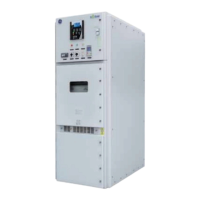SecoGear Medium-voltage Switchgear Application and Technical Guide DET-882
SecoGear Switchgear Applications
50 ©2017 General Electric All Rights Reserved
protection with time delay (27, 62 – only one required per
lineup); three-phase self-balancing machine differential
(87M); one Type GE Series 95 lockout relay (86M); zero-
sequence ground fault (50GS); and full function metering.
Additional protective functions are available in the 869.
The Multilin 869 relay operates from three current
transformers, one in each phase, a ground sensor CT, and
three current transformers located at the motor.
Optional Equipment Selection (for SMF1 and SMF2)
Protection
If six-CT machine differential relaying (87M) is required, use
GE Multilin relay 869 and six CTs (three in machine neutral
leads and three in metal-clad switchgear). Specify that the
869 relay be wired for current summation differential in lieu
of self-balance.
For starting control, synchronization and enhanced
protection in collector-ring and brushless type motors, add
the GE Multilin SPM relay. For ungrounded systems, omit the
ground sensor overcurrent relay (50GS) and the current
transformer.
When equipment is used to feed more than one motor from
the same bus, only one GE Multilin MIV undervoltage relay is
required. However, for multiple motors, add auxiliary relays
(27X), with sufficient contacts to trip each additional motor
feeder breaker.
For both smaller motors and larger motors (greater than
1500HP), complete protection including motor differential
can be obtained by using the GE Multilin 869 relay (with
motor mounted CTs).
Excitation
Field application equipment or exciter packages for a
synchronous motor are typically furnished with the motor
package. Excitation packages and panels can be sourced
and mounted in a switchgear compartment or section.
These application panels are considered custom design.
Indication
• Instrumentation and Metering: GE Multilin 869 provides
extensive metering capabilities. For circuits requiring
additional or separate metering, add a GE PQM II power
quality meter, which includes indication of all three
phases of load current, in addition to Volts, Watts, Vars,
PF, and demand functions.
• Test Blocks: For circuits that require provisions for
insertion of portable recording meters or other similar
devices, add current and voltage test blocks. The basic
current test block is wired to maintain the circuit when
the test plug is removed.
• Indicating Lamp: For circuits requiring a circuit breaker
disagreement or spring-charged indication function, add
a white indicating lamp.
Control
• Remote Control: For circuit breakers controlled from a
remote location, choose the remote control scheme from
those listed in Table 4-1. From this table, Scheme C is
recommended, since it provides maximum operating
flexibility. It requires the use of a breaker position switch
in conjunction with the breaker control switch to provide
the permissive function. With Scheme C. remote close
and trip is possible only with the breaker in the
“connected” position; local close with the breaker in the
“test” position; and local trip with the breaker in the
“connected” or “test” position.
In addition, remote control for motors requires a lockout
relay (86), which prevents breaker closing (after a relay-
initiated trip) until the lockout device is manually reset.
(The 86 device specified on SMF2 may be used for both
87M and remote control.)
Location of Optional Devices
If several optional devices are added to motor feeder
equipment, there may not be sufficient space to mount them
all. In this case, specify that the excess relays are to be
mounted on an adjacent auxiliary compartment. This makes
the vertical section a custom section.

